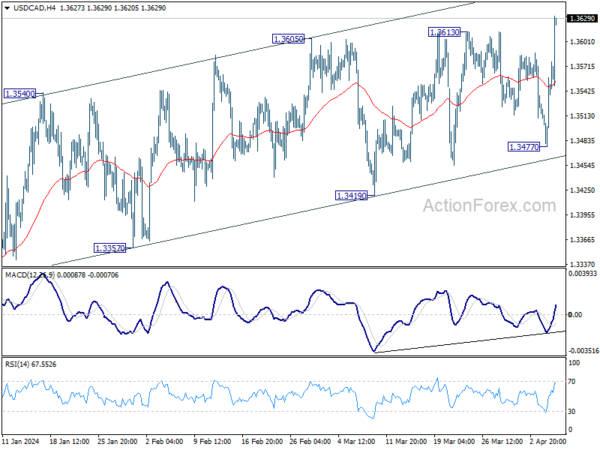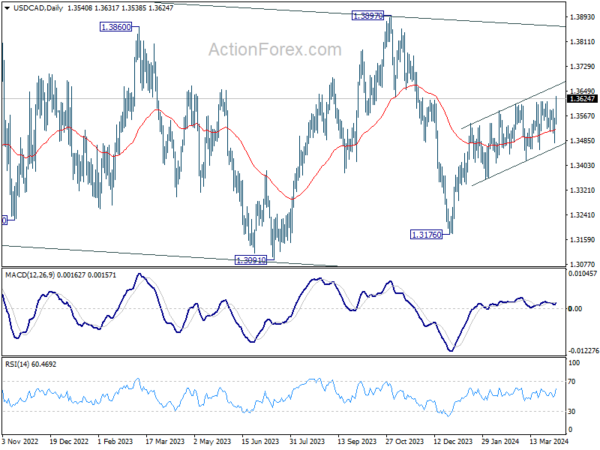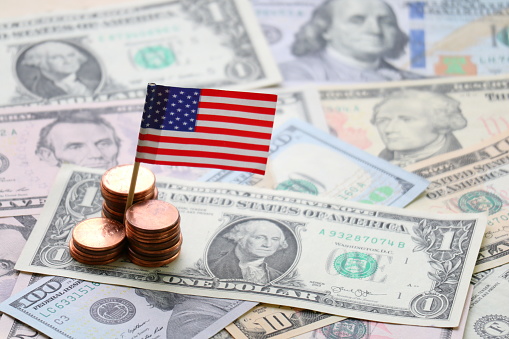Dollar rises broadly in early US session in response to surprisingly strong non-farm payroll data. Dollar’s ascent is notably pronounced the Canadian Dollar, which simultaneously grapples with its own disappointing employment figures. But against others, the overall strength of the greenback remains somewhat contained for now. The picture could shift dramatically as the NFP report catalyzes a significant surge in US treasury yields and exerts downward pressure on stock futures. Should the turmoil in stocks and bonds persist, Dollar may well gather substantial momentum later in the session.
As for the week at this point, Australian Dollar remains the standout performer, followed by New Zealand Dollar. Dollar’s ascent post-NFP has positioned it as the third strongest currency for the now. Conversely, Canadian Dollar finds itself at the bottom of the performance ladder, with the Swiss Franc not far ahead. Euro and British Pound re mixed, positioned in the middle alongside Japanese Yen. But there is room for the picture to change drastically before weekly close.
In Europe, at the time of writing, FTSE is down -1.00%. DAX is down -1.57%. CAC is down -1.51%. UK 10-year yield is up 0.050 at 4.078. Germany 10-year yield is up 0.0321 at 2.399. Earlier in Asia, Nikkei fell -1.96%. Hong Kong HSI fell -0.01%. China was on holiday. Singapore Strait Times fell -0.52%. Japan 10-year JGB yield fell -0.0066 to 0.771.
US NFP grows 303k in Mar, unemployment rate ticks down to 3.8%
US non-farm payroll employment grew 303k in March, well above expectation of 205k. That’s also much higher than the average monthly gains of 231k over the prior 12 months.
Unemployment rate ticked down from 3.9% to 3.8%, below expectation of 3.9%. Participation rate rose from 62.5% to 62.7%.
Average hourly earnings rose 0.3% mom, matched expectations. Over the past 12 months, average hourly earnings have increased by 4.1 yoy.
Canada’s employment falls -2.2k, unemployment rate jumps to 6.1%
Canada’s employment decreased -2.2k in March, much worse than expectation of 34.5k increase. Unemployment rate jumped from 5.8% to 6.1%, above expectation of 5.9%. Labor force participation rate was unchanged at 65.3%. Average hourly wages rose 5.1% yoy, up from prior month’s 5.0% yoy.
Eurozone retail sales falls -0.5% mom in Feb, EU down -0.4% mom
Eurozone retail sales volume fell -0.5% mom in February, worse than expectation of -0.3% mom. Volume of retail trade decreased for food, drinks, tobacco by -0.4% mom, non-food products (except automotive fuel) by -0.2% mom, automotive fuel in specialised stores by -1.4% mom.
EU retail sales fell volume -0.4% mom. Among Member States for which data are available, the largest monthly decreases in the total retail trade volume were recorded in Germany (-1.9%), Belgium (-1.8%) and Cyprus (-1.1%). The highest increases were observed in Poland (+1.4%), Croatia (+1.2%) and Estonia (+1.0%).
BoJ’s Ueda: Excessive Yen weakness could prompt monetary policy response
In an interview with The Asahi Shimbun newspaper, BoJ Governor Kazuo Ueda highlighted extended Yen weakness could prompt further rate hikes by the central bank.
“If exchange rate trends have an effect on the cycle between wages and prices that cannot be ignored, that would become a reason for responding to the situation through monetary policy,” he explained.
Ueda also outlined other conditions under which BoJ might consider additional rate hikes, after the landmark shift in March which exited negative interest rates.
The decision to end negative interest rates was made with a certain level of confidence, quantified by Ueda as “75 percent.” He indicated that an increase in this confidence level to “80 percent or 85 percent” could prompt further adjustments
Governor also touched on factors likely to boost personal consumption, including the government’s planned income tax cut in June, expected wage increases, and a slowdown in consumer price inflation. These developments, if they materialize as anticipated, could pave the way for a higher interest rate as early as between summer to autumn.
Moreover, Ueda acknowledged the impact of a “excessively weak yen” on Japan’s economy and consumer prices, suggesting that significant currency weakness could influence future decisions regarding interest rate hikes.
USD/CAD Mid-Day Outlook
Daily Pivots: (S1) 1.3495; (P) 1.3527; (R1) 1.3576; More…
USD/CAD’s rally from 1.3716 resumed by breaking through 1.3613 resistance and intraday bias is back on the upside. Current rise should target channel resistance at 1.3664 first. Sustained break there would prompt upside acceleration towards 1.3897 resistance next. For now, near term outlook will stay bullish as long as 1.3477 support holds, in case of retreat.

In the bigger picture, price actions from 1.3976 (2022 high) are viewed as a corrective pattern only. In case of another fall, strong support should emerge above 1.2947 resistance turned support to bring rebound. Overall, larger up trend from 1.2005 (2021 low) is still expected to resume through 1.3976 at a later stage.

Economic Indicators Update
| GMT | Ccy | Events | Actual | Forecast | Previous | Revised |
|---|---|---|---|---|---|---|
| 23:30 | JPY | Household Spending Y/Y Feb | -0.50% | -2.80% | -6.30% | |
| 00:30 | AUD | Trade Balance (AUD) Mar | 7.28B | 10.50B | 11.03B | 10.06B |
| 05:00 | JPY | Leading Economic Index Feb P | 111.8 | 111.6 | 109.9 | 109.5 |
| 06:00 | EUR | Germany Factory Orders M/M Feb | 0.20% | 0.60% | -11.30% | -11.40% |
| 06:00 | EUR | Germany Import Price Index M/M Feb | -0.20% | -0.10% | 0.00% | |
| 06:45 | EUR | France Industrial Output M/M Feb | 0.20% | 0.50% | -1.10% | -0.90% |
| 07:00 | CHF | Foreign Currency Reserves (CHF) Mar | 715B | 678B | ||
| 08:30 | GBP | Construction PMI Mar | 50.2 | 49.8 | 49.7 | |
| 09:00 | EUR | Eurozone Retail Sales M/M Feb | -0.50% | -0.30% | 0.10% | 0.00% |
| 12:30 | USD | Nonfarm Payrolls Mar | 303K | 205K | 275K | 270K |
| 12:30 | USD | Unemployment Rate Mar | 3.80% | 3.90% | 3.90% | |
| 12:30 | USD | Average Hourly Earnings M/M Mar | 0.30% | 0.30% | 0.10% | 0.20% |
| 12:30 | CAD | Net Change in Employment Mar | -2.2K | 34.5K | 40.7K | |
| 12:30 | CAD | Unemployment Rate Mar | 6.10% | 5.90% | 5.80% | |
| 14:00 | CAD | Ivey PMI Mar | 54.2 | 53.9 |









